AI Courses: Implementation in Top International Schools and Remote Areas Will Revolutionize Talent Recruitment and Training Systems
-
Students of Chaos Theory are familiar with the saying: 'The cognitive level of the founder determines the upper limit of enterprise development.' But I would like to add: The widespread application of AI will significantly raise the lower limit of enterprises, reshaping industry standards.
I believe AI will inevitably transform jobs that act as 'middlemen' in the future. The elimination of intermediaries will be the most significant change across all industries.
I think future consumerism will increasingly involve consumers directly creating products and paying for what they create. Traditional product suppliers will gradually evolve into pure providers of supply chains and manufacturing spaces.
Demographic dividends play the most fundamental and decisive role in the development of enterprises and businesses. Efficiency improvements redefine time, and when combined with new spaces, they create work and growth. The essence of an enterprise is to 'go with the flow.'
About a decade ago, I first ventured into the field of NLP (Natural Language Processing), a technology focused on how computers understand human language—today's commonly used ChatGPT, this chatbot, is essentially an NLP tool. Later, around the ages of 23 or 24, I established an incubator to provide services for various startup projects. Among these was Turing Robot, which continues to work on natural language processing and AI projects in Beijing's Haidian District, developing AI models suitable for children.
Subsequently, I invested in several AI companies, such as UISEE Technology. If you visit Baiyun Airport in Guangzhou, Hong Kong Airport, or Urumqi Airport today, the autonomous cargo vehicles and shuttle buses are all products supported by their technology. Unlike the AI tools we are familiar with today, such as ChatGPT or MidJourney, the previous wave of AI enthusiasm was primarily concentrated in the field of computer vision, with many companies focusing on visual AI processing.
Despite my previous strong connections with high-tech industries, after 2015, I became less involved in this sector. Post-2016, I shifted to the food and tourism industries, opening some trendy restaurants. When the pandemic hit, I closed the shops and spent the next two to three years mostly camping and running a camper van modification workshop.
After this year's Spring Festival, I had the opportunity to experience ChatGPT and observe the current wave of AI development. It felt like something within me was awakened—I realized I couldn't stand aside from this historic trend and recognized the revolutionary potential of AIGC. Starting in February, I began engaging in various AIGC and AI-related practices. I created courses to teach people how to better utilize AI. By mid-April, I was conducting corporate training sessions, including for listed advertising companies like Rongchang and collaborating with platforms like Bilibili for training programs. Additionally, I worked with peers from innovation institutes to develop cognitive content for private boards.
From a practical and experiential perspective, I’d like to share my views on the current state of AI development. This includes the AI tools I’ve explored and experimented with, as well as the reflections I’ve had during this journey.
Currently, I’ve divided my work and exploration in the AI field into three phases.
The first phase involved creating AI courses and conducting corporate training. During this process, I noticed that the early adopters of AI were primarily entrepreneurs, serial startup founders, and professionals from the internet industry, along with investors, lawyers, and even parents purchasing AI accounts for their high school children. Professionals from the design industry were also among the first to embrace AI, often starting their AI painting journey on platforms like Xiaohongshu. In my interactions with these users, they frequently raised similar questions, such as which jobs might be automated and how their companies could better leverage AI technology.
During May and June this year, I noticed through conversations with peers that many companies have begun incorporating AI technology to assist their work. For instance, a friend working at Daphne introduced their new brand DAPHNE.LAB focused on creative and trendy designs. Visitors to DAPHNE.LAB's Xiaohongshu page will notice that many background images in their posts were AI-generated by their design team.
At a salon event I organized in March, an architect friend shared how their firm tackled a last-minute request during a state-owned enterprise bidding process. With only three days before submission, the client demanded an additional conceptual design including modeling and rendering. Their team leveraged Midjourney and Stable Diffusion (SD) to deliver a professional-looking alternative within two days, which earned the client's approval despite being supplementary. This exemplifies how AI can rapidly generate viable design solutions.
Interestingly, my friend later observed that nearly all competing firms subsequently began submitting polished AI-assisted conceptual proposals. This development has democratized design quality - where top firms previously held advantages through elite graduates from institutions like RISD, MIT, CAFA, or Tsinghua, AI tools now enable all competitors to present concepts meeting a similar baseline standard. From the client's perspective, the gap between proposals from different tiers of design schools has significantly narrowed in initial creative phases.
Interestingly, one of my trainees who runs foreign trade and cross-border e-commerce businesses has remained an active user of ChatGPT and AI painting tools after completing the course. One particular application scenario involves their team's limited English proficiency – they now use AI to generate native-level content, including multilingual sales letters and platform-specific descriptions/comment responses. Previously, they had to hire expensive English-proficient staff (which was difficult to source in their region), but now employees with basic English skills can communicate excellently through AI, eliminating the need for specialists who understand both their products and advanced English.
This made me realize a phenomenon: The existence and widespread application of AI significantly enhance the work efficiency of entry-level employees, thereby substantially raising the baseline performance level of companies or entire industries. Many participants in our Chaos courses are founders or executives. We often hear that "a founder's cognitive level determines a company's growth ceiling," so we constantly improve our cognition and innovation capabilities to push that ceiling higher. But AI works differently – its greater impact lies in elevating the overall baseline performance of enterprises.

In conversations with founders who use AI to enhance corporate efficiency, I've realized that AI may introduce entirely new competitive challenges in various industries. Even if your company's founders and leadership continuously improve their cognitive abilities and become stronger, your company may still be eliminated from the market if your employees' capabilities or cost-efficiency fail to meet market and customer benchmarks—especially when competitors use AI to rapidly enhance their frontline staff's capabilities.
Take foreign trade as an example. If a company's email responses, sales letters, and overall communication process are highly professional, clients will grow accustomed to this standard. Compared to other foreign trade companies, they'll perceive this company as more efficient and precise in communication. If ten foreign trade companies adopt AI, all clients will consider this the industry norm. This demonstrates how rapid AI adoption can quickly raise the baseline performance and industry standards for businesses in the short term.
Therefore, I estimate that in the next two to three years, a significant opportunity will emerge: corporate training and implementation of AI-driven organizational structures and workforce transformation. Companies like Accenture are already actively working in this area. One notable characteristic of this shift is that it will substantially reduce the geographical disparities in talent acquisition caused by education and human resource distribution. Currently, cities like Shanghai and Beijing hold clear competitive advantages in talent recruitment. In contrast, smaller companies in less developed cities may face challenges. However, with AI advancement, companies—whether in major cities or smaller ones—will be able to access similarly capable and knowledgeable talent. Coupled with the rise of remote work, hiring qualified, lower-cost talent from remote areas will become a viable option for many enterprises. This is precisely why I'm currently establishing AI training and employment programs in remote regions. Students interested in supporting rural revitalization or those with needs in design creativity and cross-border e-commerce operations are welcome to join our employment initiative.
The second point I want to share is about which fields of work will be greatly impacted by AI. This is a question many people are pondering, and it has also been discussed by previous speakers—or rather, what societal changes AI might bring about. Last month, while teaching a class at an international school, a student asked me, 'I'm currently taking a programming course. Since AI can program now, is there still any point in learning programming?'
I suddenly responded to him, 'You're learning a programming language to understand how to communicate with computers, right? But what is AI? AI enables computers to understand what you say. If computers can already understand your words, do you still need to learn computer languages? You only need to develop logical thinking skills.' After answering him, it suddenly dawned on me: if AI is making machines understand human language, then once machines become intelligent enough, will we still need human translators and tool operators between humans and machines?
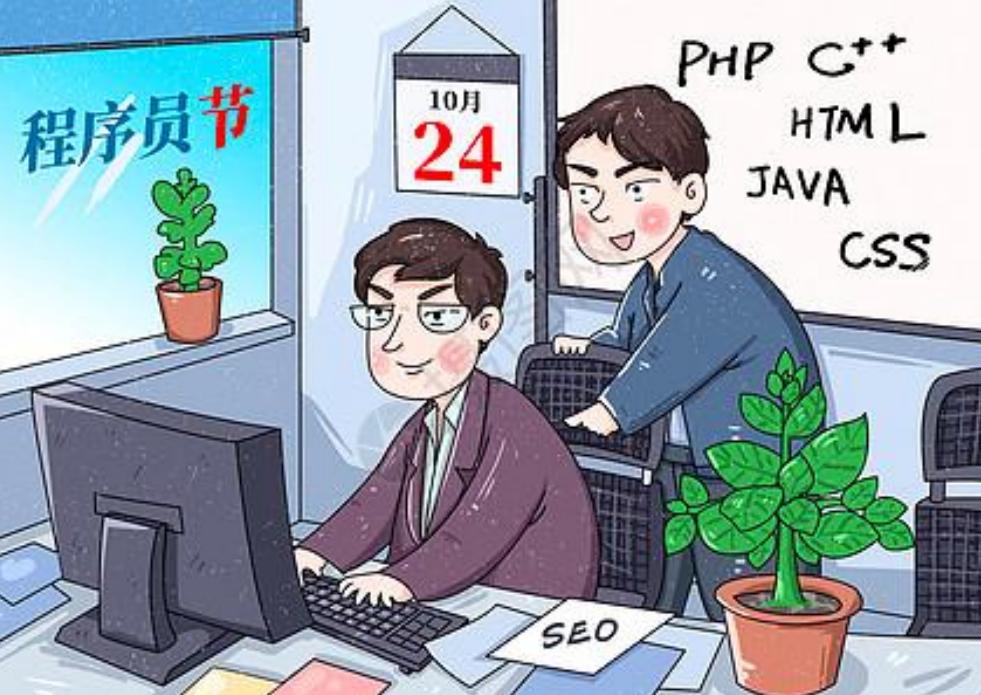
I'm sharing an image that typically illustrates the interaction process between various roles (whether as employers, product managers, clients, or practitioners) and frontline employees such as designers, programmers, document editors, or industry researchers. For example, as a boss, product manager, or client, you propose a requirement. Then, programmers use programming languages like Python, C++, or HTML to translate the requirement into computer-understandable instructions. The programmers execute these instructions, the computer comprehends them, fulfills the requirement, and finally presents the result to the boss. Alternatively, you might instruct a designer to enlarge a logo, brighten the lighting, or change the color. The designer then uses tools like Photoshop, Word, or database software to convert your instructions into software operations. The computer understands these steps and interactions, then produces the outcome.
This type of work, whether it involves design operations through tools or programming through computer languages, essentially serves as a communication bridge between humans and machines. I refer to it as "middle man" work. When machines can understand human natural language, this intermediary role will naturally disappear. Currently, it might not be entirely replaceable, but in the next three to five, or even five to ten years, it will gradually be phased out. This process is similar to the "disintermediation" of the Internet age, where the Internet directly connected people with people, spaces, objects, and information, reducing reliance on physical intermediaries and middlemen to establish direct associations. The AI field will witness a similar trend, with many large companies and institutions playing significant roles in the "disintermediation" domain.
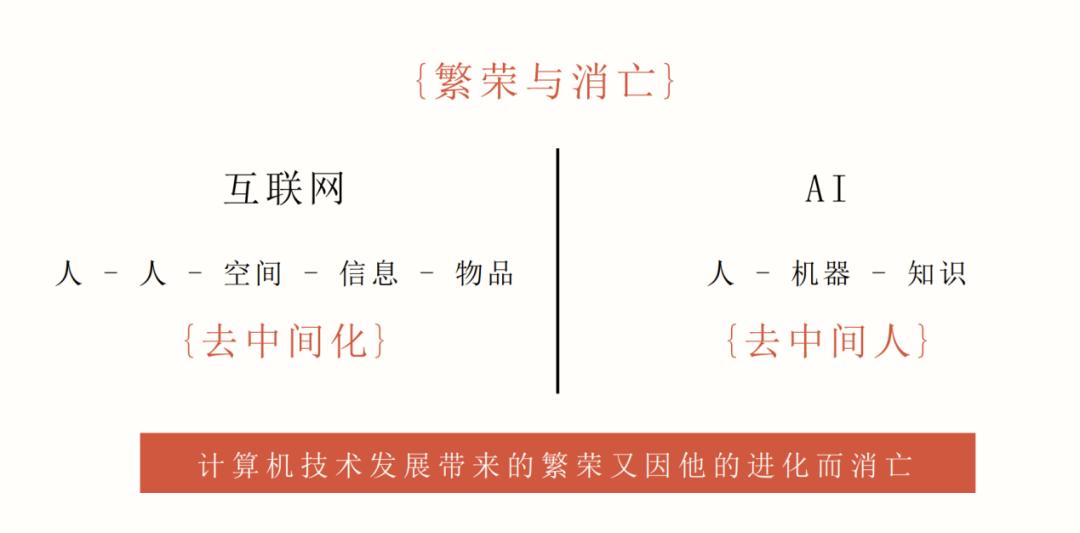
So why do I call this 'prosperity and extinction'? Interestingly, these intermediary jobs emerged precisely because of the development of computer and internet technology, yet now, with continuous technological progress, they are disappearing again. This is inherently a philosophical matter—just as the birth of the internet created countless new jobs in the 'online space' over the past decades, what kind of spatial transformation will the future bring?
These two points are what I’ve summarized based on my experience with online courses, corporate training, and various sharing sessions.
Next, I’d like to share some thoughts from my second phase of exploration. As many well-known influencers began selling courses, I wondered if I could find an idea that highlights the uniqueness of AI while also being something I’m familiar with. At the time, I loved drinking, so I opened a small bar called 'Drink GPT.' In this bar, customers could customize a cocktail based on their mood, thoughts, or creativity for the day. For example, one female customer told the AI she wanted a drink called 'Money Over Men,' or another asked for a drink called 'Buddha’s Blessing.' The AI would instantly provide a drink menu, and our bartenders would mix the drinks accordingly.
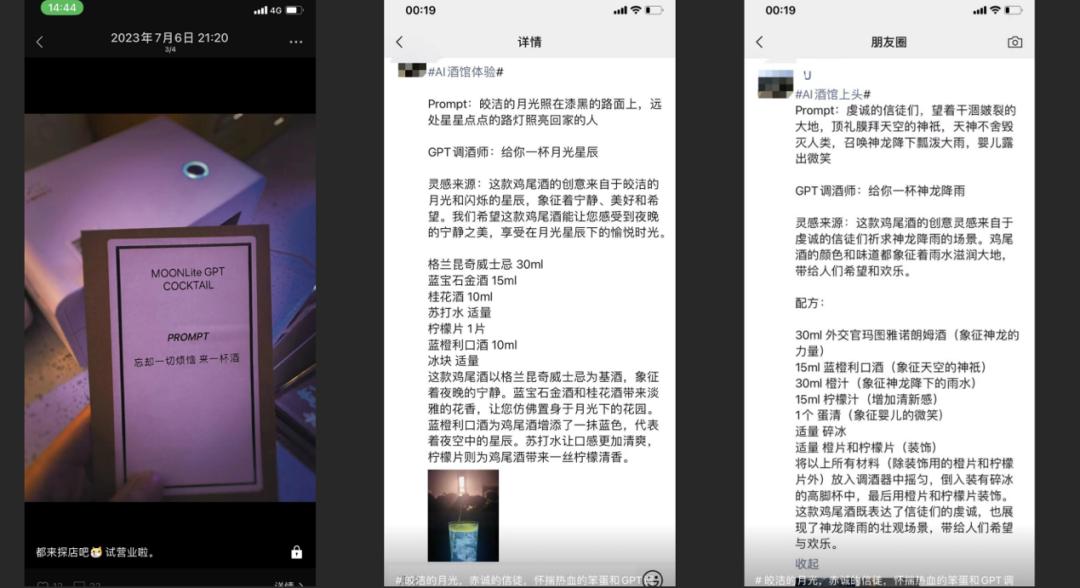
The following two images come from one of our superfans, who is a screenwriter by profession. One evening, while a few friends and I were drinking and listening to a Chinese-style electronic music demo, some friends working in film and screenwriting began creating to the music. One friend, upon hearing the music, envisioned a scene of people praying for rain in the desert, which gave him a mystical feeling. He described this scene in words and then fed the description to an AI. After reading his description, the AI immediately created a cocktail recipe. The AI also informed him that this drink was crafted by ChatGPT, explaining why the recipe was formulated this way and what the drink's name was—such as "Hidden Dragon in the Sky"—along with the meaning behind each ingredient. This experience has been highly enjoyable for many because it represents a unique, interactive process. People can also use lines from a book, a movie, or anything else to inspire the AI to create novel cocktail recipes, offering guests an exciting experience.
Later, I began to wonder why some people, especially those in creative fields, are particularly fond of this new consumption model. I've previously been involved with several bars, such as one that primarily served middle-aged white-collar women. The bartender, drawing on over a decade of industry experience, created eight to ten products specifically tailored to the target consumer group. These products were then standardized, and when consumers visited the bar, they were offered these items in exchange for payment. This represents the traditional product creation and user consumption process.
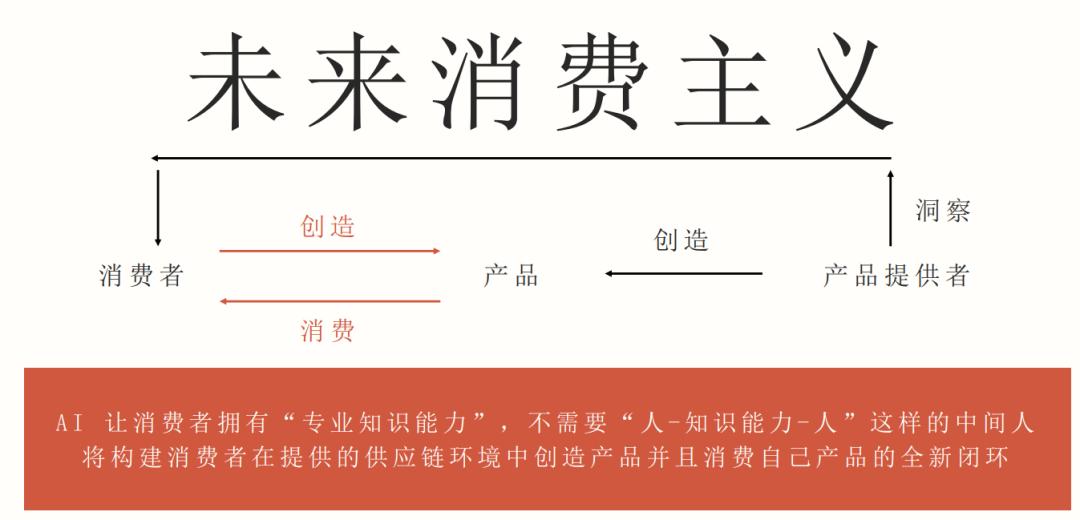
However, with this AI-powered mixology, I've noticed the process has changed. When consumers come to the bar, they now create their own cocktail products. We only provide the alcohol and other ingredients from the supply chain, along with the tools for preparation. Each consumer can conveniently create a customized product based on their taste preferences, creativity, and mood with the help of AI. This forms a complete consumption loop in some way. The process no longer relies on the creativity of the bar as a product provider, but rather on the consumers themselves to complete the creation. So why has this change occurred?
Actually, this is similar to the previously discussed characteristic of 'disintermediation.' The creation of all traditional consumer products was based on the cognition of product managers, product creators, founder teams, etc. These people relied on 15 or 20 years of industry knowledge they had accumulated. Taking alcohol as an example, they understood the alcohol content, flavors, mixing principles of various spirits, and consumer habits. However, now AI has learned thousands of years of human knowledge and made these capabilities accessible to everyone. As a consumer, one doesn't need ten years of industry experience to become a product expert or developer because they already 'possess' the creative abilities that previously only professionals had. Therefore, consumers can now create their own products. This is somewhat like navigation systems - now wherever I go, I rely on navigation. Mobile navigation has become part of my capability; I no longer feel I need to live in a city for 20 years to understand its routes and maps. With mobile navigation, I have this knowledge and capability at my fingertips. Now, AI works the same way. Whether you're a designer, biologist, alcohol manufacturer, or copywriter, you can treat AI as your navigation system, making you feel like you already have the capability to create products.
With the advancement of AI, including its maturity in text-to-3D generation, structure, and design, I believe future consumerism will increasingly shift toward consumers directly creating products through simple vernacular and paying for what they design. Traditional brands and product suppliers will gradually evolve into pure supply chains, manufacturing capabilities, and tool providers, forming a new consumption cycle. This is the insight I gained from experimenting with this new AI-driven small bar model.
Next, I’d like to share my experience of teaching AI courses in international schools, in addition to the above exploration and business. Currently, I am offering extracurricular AI courses for middle and high school students at Shanghai American School (SAS), the top-ranked international school in Shanghai, enabling them to become among the first native users of AI.
Some might ask, why teach this course in international schools? First, I adopt the "first principles" approach, starting from fundamental truths to examine my current role as an international school teacher. I highly value a practical concept: when pursuing first principles, I reflect on the most basic and essential questions. I believe demographic dividends play the most foundational and decisive role in the development of enterprises and businesses. Although many companies have succeeded, the underlying essence is 'going with the flow.'
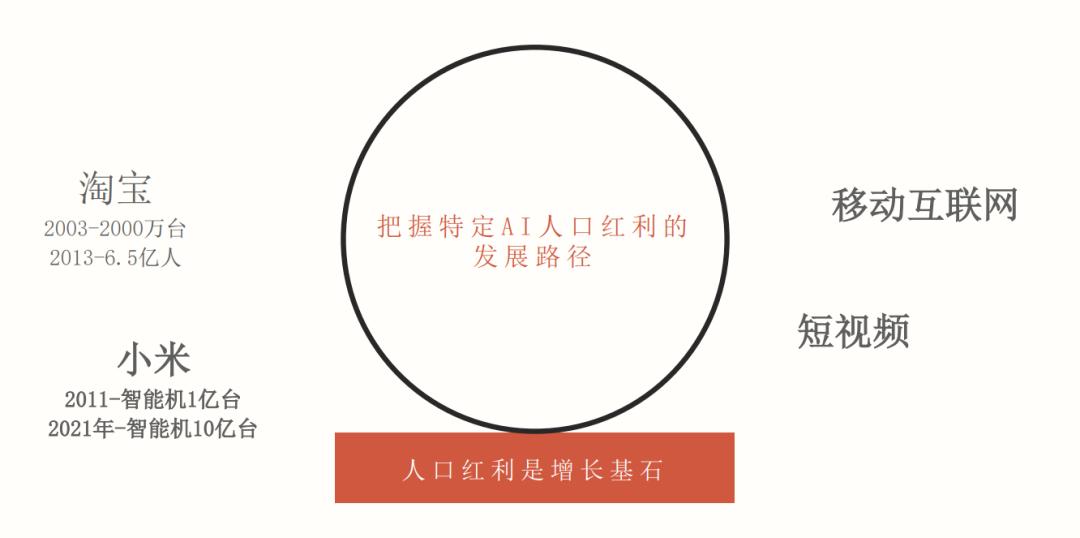
For instance, the early digital demographic dividend saw Taobao launch in 2003 when China had only 20 million internet-connected devices. By 2013, just a decade later, China's internet users surged to 620 million—an increase of 600 million users. This massive user base drove consumption exceeding 1 trillion yuan, propelling industry-wide growth.
Similarly, Xiaomi was founded in 2011 when China had merely 100 million smartphone users. By 2021, smartphone ownership reached 1 billion, with 900 million new users added, creating an industry expansion worth over a trillion yuan. Earlier, urbanization's demographic dividend also brought prosperity to real estate companies. The short video industry grew even faster, expanding from thousands to over a billion users in just a few years. Therefore, I believe the core of every development opportunity lies in "going with the flow" or capitalizing on demographic dividends.
Consequently, I view AI as one of the key opportunities everyone should seize, explore, or participate in over the next decade—primarily because AI undoubtedly possesses its own demographic dividend.
We use a chaotic approach to deconstruct the demographic dividend of AI and explore why we should pay attention to young middle and high school students. Looking ahead five to ten years, we need to conduct a detailed analysis of the 2022 population structure. Currently, there are approximately 400 million people aged 50 to 75, many of whom have already adopted some AI applications, such as AI chatbots, AI-assisted tools, and smart devices. The adoption rate of these applications is relatively high, and it may reach 50% in the future, equivalent to about 200 to 300 million people. However, most people, including the audience I am considering, are primarily concentrated in the 20 to 50 age group. This generation is gradually adapting to working alongside AI or may eventually compete with AI for jobs. In China, this group comprises about 580 million people.
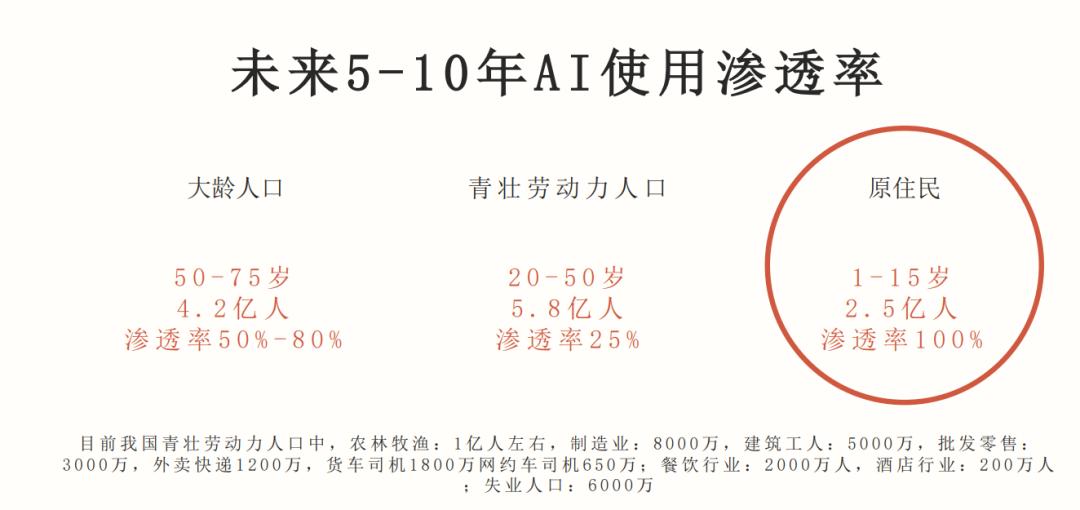
But when we further segment this population, we find that there are about 100 million people in agriculture, forestry, animal husbandry, and fisheries, around 80 million in manufacturing, approximately 50 million in construction, 30 million in wholesale and retail, 12 million in delivery and courier services, 18 million truck drivers, and additional unemployed individuals. For example, the catering industry employs about 20 million people, while ride-hailing and taxi drivers account for roughly 10 million. Therefore, the proportion of the population that may actively use AI or be affected by AI in terms of work and competition is likely around 20%, or about 100 million people. Consequently, our current efforts in developing various AI applications—whether in AI painting, AI e-commerce, or from a demographic perspective—are targeted at this segment of the population.
Through further research, I discovered that there are approximately 250 million people aged 1 to 15. I believe this group can be referred to as "AI natives" because they are born into an era where AI is ubiquitous. For them, growing up without AI is unimaginable, much like navigating a city without a smartphone today. AI penetration for them is 100%, and regardless of their parents' professions, they will undoubtedly recognize the necessity for their children to learn AI as it represents the future societal trend.
In this irreversible process, we began to consider which segment of this population might be the first to shift focus from academic pressures to AI learning. Our analysis revealed that China has over 1,000 international schools. We believe students in these institutions are likely to dedicate significant time to AI education. Consequently, we have already started introducing AI-related courses in these schools.
This approach—using "first principles" thinking to identify suitable business opportunities—is crucial. My background in STEAM education has provided relevant experience in this endeavor. Over the next five to ten years, this represents a significant demographic dividend, and I have chosen to actively participate in it.
For the post-2010 generation, AI will be an integral part of their upbringing. They cannot conceive of a world without AI or the societal implications of lacking these skills, just as we cannot imagine reverting to paper maps. This underscores the importance of focusing on nurturing this young generation now.
The underlying logic of traditional education can be likened to a coin with two sides. One side represents tools—the skills to use them—while the other side represents thinking, or how to apply these tools in practice. For example, when studying design in college, you learn to use tools like Photoshop, Illustrator, and Adobe. This is one side of the coin. Through using these tools, you gradually develop your design thinking and construct a design-oriented thought process. This is the other side of the coin.
However, tools are no longer the sole focus, especially in interactions with computers. This means cognitive training has become increasingly important—even critical. Students need to move beyond tools and engage in direct cognitive training. This is also the foundational logic behind the design of our course.
Additionally, knowledge accumulation and foundational understanding will grow in importance in the future. We teach students not only to master tools but also to grasp fundamental knowledge across various fields, such as narrative storytelling, lighting angles, and art history. These theoretical concepts become indispensable in practical applications. For instance, when collaborating with AI to create visuals, you need to understand the styles of different directors and artists to achieve the desired effect. Without this theoretical knowledge, effective communication and collaboration with AI would be impossible. In the past, subjects like art history might have been dismissed as impractical, but with the rise of AI, such knowledge has become essential. In this era, learning programming languages like Python is no longer the priority; instead, theoretical knowledge is key to guiding collaboration with AI. These shifts reshape our perspective on education and inspire new insights when addressing business-related challenges.
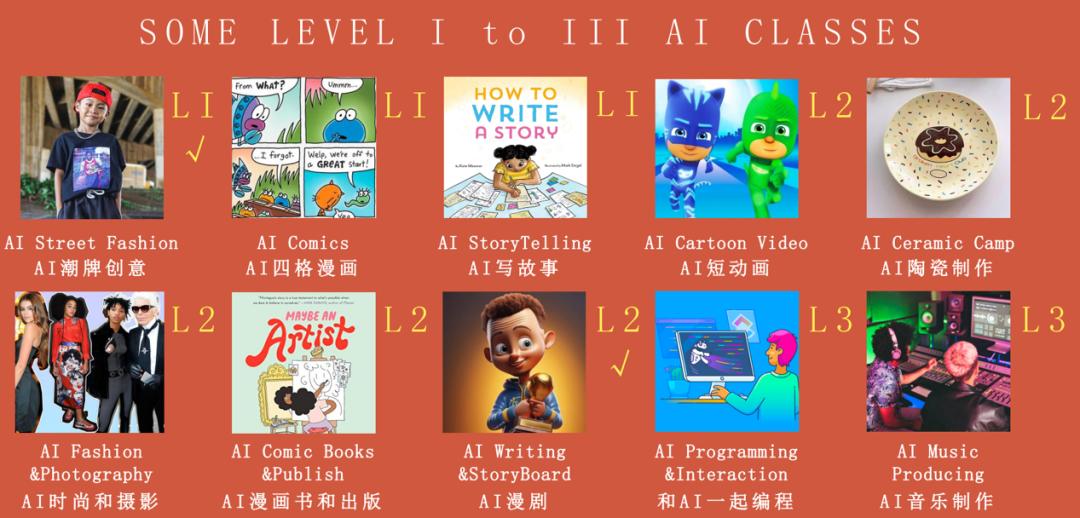
Therefore, AI education needs to be integrated into courses at different levels. Students may discover their strong interests in certain fields, such as fashion, painting, comics, cartoons, crafts, ceramics, film, programming, technology, or music. They will think about how to apply AI in these areas. We believe that AI will become a useful tool in the industries they love, whether for adults or children. Just as we used maps or mobile navigation apps to navigate cities in the past, today's AI navigation apps can guide you in various professions, products, and fields, helping you find the right path. Therefore, what every child or individual needs is to clarify their goals, understand the directions they can take, learn how to use AI to spark creativity, and put effort into practicing what they love. This is my understanding of AI applications today.
